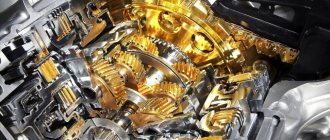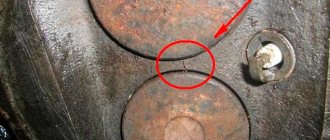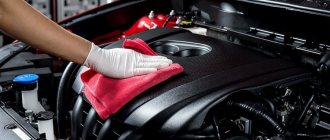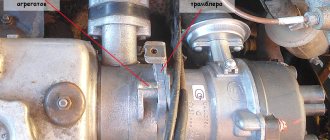The catalyst is an integral part of the exhaust system. If it is clogged, it does not fulfill its function of neutralizing harmful substances released by the machine. If the catalyst is clogged, how does the car behave?
Signs of a clogged exhaust gas catalyst:
- the engine starts and immediately stalls;
- the car began to accelerate slowly;
- when you press the gas pedal you feel resistance;
- clogged catalyst, fuel consumption has increased significantly;
- when starting the engine “cold”, an unpleasant, pungent odor is felt;
- The check engine light is on;
- oil consumption has increased.
Find out the cost of catalytic converter diagnostics online in 3 minutes.
Don’t waste your time, use the Uremont search and get offers from the nearest services with specific prices
Get prices
Clogged catalyst. What are the reasons?
The reasons for the incorrect operation of the catalytic converter are various factors. The main ones are the following: low quality fuel (the engine breathes worse), high oil consumption, incorrect settings of the ignition system, mechanical damage, and incorrect operation of the exhaust system. Due to these factors, the filter becomes clogged.
What does a clogged catalyst look like? It's better to see once than to read 100 times. The photo shows a clogged catalyst.
In domestic cars (VAZ, Kalina, Lada Priora, Niva), a common cause of breakdown is problems in the ignition system.
The problems with foreign cars (Nissan, Opel, Peugeot, Ford, Solaris, Audi, Lacetti, Lancer) are identical: power is lost, a noise is heard in the body, like small crushed stone, the engine is unstable.
Signs of a faulty catalytic converter on a car
A driver, even with little experience, can easily determine the presence of a malfunction in the exhaust system, which is most often associated with the catalyst. If the exhaust gases begin to flow poorly into the exhaust, this will affect the “behavior” of the car and engine as follows:
- The car will begin to have difficulty picking up speed. In this case, the problem is felt up to a certain point, which depends on the degree of contamination or damage to the catalyst. For example, when accelerating along a suburban highway, the car will slowly increase speed in low gears, and when shifting to a higher gear (and accelerating at high speed), it will begin to operate in normal mode. It may feel like there is a heavy load in the back of the car, causing slow acceleration;
- The Check Engine light is on. When the catalytic converter is heavily contaminated, some electronic control units turn on a light requiring an engine check so that the driver understands that there is a malfunction. In this case, an error message P0420 may light up on the on-board computer - a problem with the efficiency of the motor;
- Fuel consumption has increased. Due to a contaminated catalyst, fuel consumption increases. Please note that an increase in consumption indicates a malfunction in the exhaust system only if there is a problem with slow acceleration.
If the catalytic converter is severely damaged or clogged, the engine may not start. Or the engine will start, but after a few seconds of operation it will stall.
The catalyst is clogged. How to check it yourself?
You can diagnose the breakdown yourself using your senses: - Shine a powerful flashlight inside the part to visually identify the fault. For convenience, lift the car on a bracket, if possible. - Take a sniff. If the catalyst emits a sharp and unpleasant odor, then a breakdown is obvious. — Place your hand near the exhaust pipe. If you feel resistance tactilely, then the catalyst is working. If not, then there is a need for repair.
Catalyst testing
The first way is, of course, to remove the catalyst and have a look. If it is clogged, try cleaning it; if this is not possible, then it needs to be changed. The second way is to check the catalyst by measuring the anti pressure. That is, without removing the catalyst, we unscrew the lambda probe and screw in the pressure gauge. A pressure gauge is required that measures pressure up to 1 kg/cm3. Even with a working catalyst, there is a slight anti-pressure, but its magnitude is not such a maximum. The permissible pressure is from 0.35 to 0.5 kg/cm3; if the pressure exceeds these figures, then this tells us that your catalyst is already clogged.
Catalytic Converter Repair
Removing the neutralizer looks like this: ceramic parts are removed from the catalyst, and then the empty block is mounted back. Where the car has “brains”, it also requires “reflashing”.
When replacing with a flame arrester, instead of the damaged filling, a pipe with many holes is installed. The free space is filled with basalt wool. It is cheap, the requirements for the quality of gasoline are reduced, it lasts a long time, and does not resist gases (the engine's operation is made easier). Among the disadvantages: the exhaust sound is louder, the exhaust system will last less due to the high temperature of the gases. The exhaust composition does not meet the standards.
You can also install a universal catalyst. The part itself and its installation are cheap. This is a good alternative when there is not enough money for an original catalyst.
It is possible to replace it yourself if you have welding skills. You remove the pipe, cut out the old pipe with a grinder, and weld another one.
Symptoms when the catalyst on a car is clogged
There are several characteristic signs of a clogged catalyst. The first is a reduction in maximum speed; if you have owned your car for a long time, you know it like the back of your hand. Since the catalyst does not clog immediately, but gradually, you should feel a lack of power at high speed. Let’s say you used to easily reach a speed of 150 km/h in your car. Then, with the degree of contamination of the catalyst, it will be more difficult for your car to reach this speed, and over time this speed will drop to 120 km/h, then even to 90 km/h. What does this mean? And the fact that at the exit from the engine, the exhaust gases rest against the clogged honeycombs of the catalyst and begin to return back to the engine, so-called anti-pressure is created. Of course, with this anti pressure the error should light up, but for one reason or another the error does not light up.
The second indirect reason for catalyst failure is failures during acceleration, the so-called turbo lag effect. That is, when you sharply press the gas pedal, the engine delays and after a short period of time acceleration begins.
The third reason is increased fuel consumption. Trying to achieve the speed you need, you press the gas pedal, but the car simply does not move and you have to constantly keep the engine at high speeds. If your car shows these telltale signs of catalytic converter failure, then you need to start testing it.
Consequences if the catalyst is not repaired
What does a clogged catalyst affect? Today, in 80% of cases, operating a car with a faulty catalyst can lead to replacing the internal combustion engine. Firstly, there is a risk of not starting the engine. Secondly, if the element is physically destroyed, ceramic particles can get into the cylinders. In this case, a major overhaul will be required.
In conclusion, we say that in many modern cars the computer will inform the car owner about the malfunction. To diagnose a problem with the filter yourself, you can use the signs that we indicated in this article. Replacing the catalytic filter in the event of a breakdown is the best solution. There is also a cheap alternative: installing a flame arrester. It dampens noise and temperature, but does not solve the problem of environmental pollution.
Signs of a faulty catalyst
The catalyst breaks down quite often, since this element plays the role of the main filter in the car. To avoid having to worry about which parts need repair immediately, vehicle owners should know how to check the catalyst. Fortunately, if there are any problems with this element, the car will clearly demonstrate its problems.
Of course, all car models are unique to each other. Therefore, a broken catalyst in different brands will behave differently. But there are common features that all car owners who have encountered such a problem at least once have noticed.
In general, a faulty catalyst in most cases manifests itself as follows:
A signal appears on the dashboard. Having seen the “Check engine” icon, the driver should immediately pay attention to the entire exhaust system. But this sign cannot 100% indicate that the problem lies in the catalyst. But it is this element, of all the spare parts that form the correct exhaust system, that breaks more often than others. Moreover, the “Check engine” icon may light up if the problem is not related specifically to the catalyst itself, but to the connecting elements.
Low dynamics. A machine that shows no obvious signs of malfunction should be accelerated within its specifications. If the owner of a vehicle begins to notice how his car picks up speed too slowly, and over time cannot “squeeze out” the previously achieved speed limit (for example, 120 km), the likely cause of this weakening is a problem with the catalyst. This, by the way, is the most obvious sign of its clogging.
The appearance of unnecessary noise. Of course, the machine cannot operate completely silently. But if strange sounds appear that were not heard before after starting the engine, this may be due to a clogged catalyst.
Smell of hydrogen sulfide. This indicator cannot guarantee that the problem is related to the catalyst. The “aroma” of hydrogen sulfide is specific to many problems, including engine and transmission problems. Therefore, if an unpleasant odor occurs from under the hood, you should pay attention to whether there are other signs that characterize the presence of a certain problem with the car.
If several signs occur at once, the likelihood that the element has failed is quite high. In such a situation, you should know how to check the catalyst for clogging with your own hands. This will help avoid additional waste when contacting auto repair shops.
Motor tester diagnostic method
An engine tester is a set of various pieces of equipment, with the help of which specialists calculate various breakdowns inside the car. Data analysis is performed on the basis of a so-called oscillogram. When conducting such an analysis, the spark plug is removed and a device is installed in its place to identify problems. After this, all the readings are analyzed, and you receive a verdict on your problems and further advice on how to fix them. It is worth understanding that you will not be able to check the exhaust at home, since you will not have sufficient equipment, as well as money to purchase specialized software, which actually shows this very data.
Important note: service your vehicle only at authorized service centers. Otherwise, you may lose money and even some parts of your car. Unofficial service stations may employ unscrupulous people who can steal your part and replace it with a cheaper one.
Catalyst diagnostics
If you have a question about how to check the operation of the catalyst on a car, then we will tell you about it. To determine a breakdown, auto mechanics use some methodology. So, how to check the performance of the catalyst? In order to find out which specific cells were clogged, you need to do the following manipulations:
- Start the engine. Try to achieve maximum speed when operating. While the engine reaches minimum, medium and high speeds, try to press the gas pedal sharply. If the engine responds immediately to your actions, then everything is functioning normally. If the engine does not react immediately, but after a few seconds, or the number of revolutions does not exceed 5 thousand revolutions, then you need to contact a service station. Most likely, this part will need to be replaced.
- The next way to check the catalyst is to put your hand on the exhaust pipe. Exhaust gases move impulsively. Having done this action, you will be able to feel how the cylinders take turns releasing exhaust gases from the exhaust. At idle, the exhaust flow should also be impulsive. If you feel a smooth movement, then your device is clogged with waste.
Article on the topic: Choosing an air filter
In addition, you can cooperate with your assistant and tell him to start the engine, increase the engine speed, and immediately turn it off. Once the engine is stopped, you will be able to see contaminated gases slowly escaping from the exhaust port to confirm your suspicions about the problem.
Why does the catalyst clog?
If we exclude cases of the car being involved in an accident or damage to the exhaust system as a result of the bottom hitting an obstacle, then there are three main reasons.
Poor fuel quality. When it burns, the temperature may be higher than permissible. The components of the main element, the carrier, melt and fail. Additives with iron particles added to the fuel neutralize the working surface of the honeycomb. As a result, the chemical reaction stops and the catalyst stops working.
Cell filter clogged. The cells become clogged with soot, soot, etc. This prevents exhaust gases from passing through them.
What is a catalyst and how does it work?
Exhaust gases are waste products from engine operation.
It consists of many toxic chemical compounds that cause serious damage to human health and nature. A catalyst is a device that levels their concentration to a minimum value. It is built into the car's exhaust system between the engine and the muffler.
The catalyst consists of three main parts:
- Filter element or media . It consists of honeycomb cells in which, at high temperatures, neutralization (combustion) of harmful gases and fuel residues occurs.
- Thermal insulator . Necessary to maintain the required temperature inside the device.
- Metal casing with ventilation perforation . Protects the product from inadvertent contact with a hot device.
The operation of the catalyst is monitored by sensors. The first of them is located before the neutralizer. It records information about the amount of unburned fuel in the exhaust gases. Another sensor monitors the quality of exhaust gases at the outlet of the catalyst. Information from the sensors is transmitted to the engine ECU, which regulates the fuel supply.
Over time, the honeycomb structure of the catalyst becomes clogged and the device ceases to fulfill its purpose. Next we will look at the main signs of a clogged catalyst.










